Home
A comprehensive resource for safe and responsible laser use
US: Advisory committee recommends pilot procedures, training and glare protection
ARP6378™ has three main parts:
- A description of how lasers can interfere with pilots’ vision and operational performance, and how pilots can reduce adverse effects.
- A recommendation for pilot training, including exposure to safe, simulated laser light in a simulator or other realistic flying environment
- A description of Laser Glare Protection eyewear and windscreen film, with recommendations for whether and how to use these.
The document was developed by the SAE G10OL “Operational Laser” committee over a two-year period. It is available for purchase from SAE for $78. A three-page preview, which includes most of the Table of Contents except the appendices, is here.
From SAE ARP6378™, “Guidance on Mitigation Strategies Against Laser Illumination Effects”, published June 2 2018. Available from SAE.org.
Click to read more...
UK: New UK law provides stronger penalties, easier prosecution for aiming a laser at a vehicle
The penalties for violations are up to five years imprisonment and an unlimited fine; these penalties take effect starting July 10 2018.
The law applies to laser beams aimed at aircraft, motor vehicles, trains, ships, hovercraft and other vehicles. A vehicle does not have to be moving at the time of offense; if the engine or motor is running then the law applies. Another provision makes it an offense to shine or direct a laser beam towards an air traffic facility, or a person providing air traffic services, under the condition where the beam dazzles or distracts, or is likely to dazzle or distract a person providing air traffic services.
The offense is a strict liability offense, meaning that prosecutors do not need to prove that the person shining the laser intended to endanger the vehicle or air traffic facility/controller. There are two defenses allowed: 1) the person had a reasonable excuse for shining the laser beam, or 2) the person did not intend to shine a laser at the vehicle/ATF/controller and exercised all due diligence to avoid doing so.
Click to read more...
New Zealand: Pilots want high-powered laser pointers banned
The April 18 2018 call for prohibition follows two recent reported incidents:
- On April 12 an Air New Zealand plane was hit by a laser strike near Kerikeri Airport at about 6:10 am, just after taking off
- On April 15 there was a laser illumination of a Mount Cook Airline plane flying over the Canterbury town of Rolleston
There were approximately 169 laser/aircraft incidents in 2017, according to the Civil Aviation Authority.
NZALPA news from the New Zealand Herald, details on Kerikeri incident from Stuff Travel, details on Rolleston incident from The Press. Click the “read more” link for additional details in the NZALPA April 18 2018 press release.
Click to read more...
UK: "Call for evidence" response summarizes many groups' views on laser eye, plane incidents; sets forth actions
The U.K. government published on January 8 2018 a 14-page report on laser pointer safety and potential regulation. The report includes two new actions the government will take to reduce the number and risk of unsafe laser pointers:
1) “strengthening safeguards to stop high-powered lasers entering the country”, and
2) “working with manufacturers and retailers to [voluntarily] improve labeling.
Separately, the U.K. government published the Laser Misuse (Vehicles) Bill on December 20 2017. This makes it illegal to point a laser at vehicles, with a prison term of up to five years and an unlimited fine.
“Laser pointers: call for evidence - government response”
From August 12 to October 6 2017, the Department for Business, Energy and Industrial Strategy opened a “Call for Evidence” consultation. BEIS set forth 19 questions, asking the public to give their views on laser pointer hazards and what actions to take.
The January 8 2018 government response summarizes the 265 responses received.
The report is especially useful because it incorporates the views of many disparate groups: pilots (64% of respondents), “concerned members of the public” (14%), professional laser safety advisors (9%), users of laser pointers (6%), ophthalmologists (6%), and Trading Standards authorities (2%).
The report then distills these views, finding surprising commonality. It is a good overview for the non-expert on two topics:
1) Actual laser pointer hazards — separating fact from fear
2) Potential actions to reduce the number and severity of laser pointer injuries and incidents — including what actions may not work (e.g., licensing).
We have summarized the findings below (click the “read more” link). However, reading the complete document is well worth the time of anyone interested in this issue.
Click to read more...
UK: New UK law to provide stronger penalties, easier prosecution for aiming a laser at a vehicle
The text of the bill is here. A House of Lords Summary Briefing, giving some background, is here.
Tough new penalties for misuse of lasers
People who target transport operators with laser devices could be jailed for up to 5 years under new laws designed to protect the public.
The Laser Misuse (Vehicles) Bill, which was published today (20 December 2017), will also expand the list of vehicles, beyond just planes, which it is an offence to target with lasers.
Drivers of trains and buses, captains of boats and even pilots of hovercraft will be among those protected by the new legislation.
The bill will make it easier to prosecute offenders by removing the need to prove an intention to endanger a vehicle.
And it will remove the cap on the amount offenders can be fined – which is currently limited to £2,500 – paving the way for substantial sanctions. Fines could be issued in isolation or alongside a prison sentence.
The police will also be given additional powers to catch those responsible for the misuse of lasers.
Aviation Minister, Baroness Sugg said:
“Lasers can dazzle, distract or blind those in control of a vehicle, with serious and potentially even fatal consequences.”
“The government is determined to protect pilots, captains, drivers and their passengers and take action against those who threaten their safety.”
Alongside their existing powers of arrest and the ability to search a person once arrested, officers will no longer need to establish proof of intention endanger to a vehicle, aircraft or vessel, making it easier to prosecute swiftly. It will be an offence to shine or direct a laser towards a vehicle if it dazzles or distracts the operator, if done deliberately or if reasonable precautions to avoid doing so are not taken.Click to read more...
UK: Pilots upset after proposed anti-laser law dropped
Despite “dangerously high” figures on laser attacks on aircraft, the new Government has dropped plans to introduce tougher laws, a move which the UK pilots’ association says is “infuriating and dangerous”.
BALPA had been campaigning for the tougher laws in response to consistently high reports of laser attacks on planes year on year. Last year’s figures stood at more than 1,200 reported attacks.
Before the [June 8] general election, the British Airline Pilots’ Association (BALPA) was pleased to see a specific laser offence included in the Vehicle Technology and Aviation Bill. The new offence proposed that offenders could face up to five years in prison if they shone a laser at an aircraft.
However, BALPA has now learned that the Bill will not now include the laser regulations.
The association has constantly warned that shining a laser at aircraft is extremely dangerous, particularly in critical phases of flight such as take-off and landing, putting the lives of passengers at risk. BALPA General Secretary, Brian Strutton, said:
“It is infuriating to see the changes we’d hoped for appear to have been discarded. Not having this legislation is dangerous and puts the lives of passengers and crew at risk.
“The proposed tougher laws received cross-party support so it’s baffling that they have been dropped.
“When a laser pen is pointed at an aircraft it can dazzle and distract the pilot, and has the potential to cause a crash. Last year’s incident figures remain dangerously high, with the equivalent of more than three laser attacks a day across the UK.”
The Guardian has a June 22 2017 story about BALPA’s criticism, with additional information and statistics on U.K. laser incidents.
An April 20 2017 analysis of the Vehicle Technology and Aviation Bill, written by the law firm of Addleshaw Goddard LLP, had this description:
The Bill makes it an offence to direct or shine a laser beam at a vehicle in such a way as to dazzle or distract the person driving, piloting or navigating that vehicle.
This offence is not completely new. Under section 225 of the Air Navigation Order 2016, it was an offence to 'dazzle or distract' the pilot of an aircraft and under section 240 it was an offence to 'recklessly or negligently act in a manner likely to endanger an aircraft, or any person in an aircraft'. Many have argued these offences are insufficient as they are limited to aircraft, and are summary offences only which restrict police powers. The new offence therefore applies to all 'Vehicles', which are defined as anything used for travel by land, water or air and so will apply in relation to trains, buses and other forms of transport. The penalties remain the same: a maximum fine and imprisonment for up to 5 years.
However, many still consider the new offence insufficient. A number of organisations and rights groups wanted lasers to be reclassified as offensive weapons when used in some circumstances, particularly following the failure last year of a Private Members Bill which had sought to make the sale of high wattage lasers unlawful in certain circumstances.
UK: BALPA calls for high-powered lasers to be treated as offensive weapons
BALPA noted that there were 1,439 reports of laser attacks in 2015, and that 55% of pilots experienced a laser attack in the past 12 months. A spokesperson said BALPA “has been campaigning for a long time for high-powered lasers to be treated as what they are — offensive weapons.”
The association was also concerned with the threat of incidents involving drones.
A motion to ask for improved regulations passed at the meeting.
From a BALPA press release
US: Pilot group forms to combat laser strikes
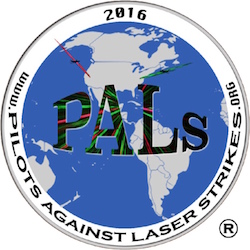
On the education side, volunteers will visit schools and airports to provide information about why people should not aim lasers at aircraft.
On the legislative side, the group wants to create a National Laser Registration List for Class 4 lasers (those over 500 milliwatts of power), with federal law mandating registration.
PALS was founded in March 2016 by pilot Craig Pieper, who was illuminated by green laser light in December 2015 while on approach to Newark Liberty International Airport. The organization’s website is at pilotsagainstlaserstrikes.org.
From Aero Crew News August 2016, pp. 26-27 and Metropolitan Airport News, August 2016, p. 10.
UK: Consumer lasers hazardous up close, but will not injure pilots, say 3 top UK experts
But in addition to this declaration, the authors also provided a succinct summary of the current state of consumer laser pointer misuse, and how ophthalmologists should proceed when studying a patient’s laser exposure.
Experts John Marshall, John O’Hagan and John Tyrer began by noting that low-powered Class 2 (less than 1 milliwatt) and Class 3R (1-5 mW) lasers “are not an eye hazard, and even if used inappropriately will not cause permanent eye damage.”
However, consumer laser devices with Class 3B (5-500 mW) and Class 4 (above 500 mW) powers have begun to cause injuries. “….[C]lass 4 devices are capable of causing irreversible retinal damage if directed into the eye over short ranges, up to several metres. Such devices have resulted in foveal injuries in children with current estimates of 150 cases in the UK. The [UK] media has given significant coverage to this growing problem.”
Ophthalmologists were advised that in cases of close up exposure, there may potentially be permanent damage. A detailed examination would be warranted, although there is no treatment to reverse permanent damage.
The hazards from this short range misuse differ from the hazards of aiming a laser towards pilots. Because the laser-to-aircraft distance is typically “hundreds to thousands of metres”, and because of scattering from the windscreen, eye injuries are nonexistent: “Fortunately, these exposures are at irradiances that are incapable of producing irreversible retinal damage even at distances of 100 m.”
They said that only one case of alleged retinal damage has been reported in pilots. [LPS.com note: this is for publicly available reports involving civilian pilots.] The experts concluded the case is suspect for a number of reasons; they do not believe laser targeting caused the alleged injury.
Marshall, O’Hagan and Tyrer turned from injuries to the hazards of distracting pilots with bright laser lights: “Obviously, if such a distraction occurs at a critical time such as during landing then the result could be devastating.”
For ophthalmologists examining pilots, if there are no permanent abnormalities on an Amsler grid test, the physician should not do any detailed eye exam, as this “would only serve to compromise the pilot's vision for a longer period.” The authors noted that pilots may delay seeing an expert for “many hours or a day or so during which there may be a growing psychological element.”
In an interview with CNN, Marshall said the findings on pilot hazards are based on previous laser safety research as well as a new study done with field experiments at a military base over about three years.
In the BJO editorial, the three experts agreed that current laser safety standards and guidelines are based on valid experiments and science. The standards do not need to be revised, “…but clearly further attempts must be made to educate the public.”
The editorial concluded “The European Commission has mandated the European Standardisation bodies to produce a standard specifically for consumer laser products. This should allow enforcing authorities to remove unsafe products from the market. However, compliance by manufacturers will remain an issue, as will direct imports by the public purchasing unsafe laser products over the internet.”
From the British Journal of Ophthalmology editorial “Eye hazards of laser ‘pointers’ in perspective” by John Marshall, John O’Hagan, and John Tyrer, available in HTML text and as a PDF document. Click on the blue “Read More…” link below for an April 19 2016 press release from the BJO summarizing the paper’s findings relative to pilot hazards.
Click to read more...
Canada: 590 laser/aircraft incidents in 2015; pilot group wants handheld lasers classed as weapons
The head of the Air Canada Pilots Association said that the figures show that education is not working, and handheld lasers should be designated as prohibited weapons.
From CBC News. Note that a few days later, the Ottawa Citizen did an analysis of Transport Canada’s database which shows different figures: 663 laser incidents in 2015, which is up 32% from the 2014 total of 502.
Canada: After 461 lasings in 2013, pilots want stricter penalties plus government controls on lasers
In addition, Capt. Craig Blandford said “We’d (also) like to see a control put on them, some kinds of permits or access to these things that’s somehow controlled. I’m not sure to go so far as to say we want them on a prohibited weapons list, but that’s one of the things that we’re pursuing in order to get stricter on control.”
In 2013, there were 461 laser/aircraft incidents reported to Transport Canada, as compared with 357 in 2012. As of February 12, there have been 44 incidents in Canada during 2014.
From the Ottawa Citizen. The story includes additional details on Canada statistics and the pilots’ proposals.
Australia: UFO hunters warned to avoid aircraft
Barry Jackson, an A380 pilot and former president of a pilot’s association, cautioned in early January 2014 that this can be “extremely dangerous” for aircraft that are landing.
UFO hunter Alan Ferguson agreed with Jackson’s characterization of the danger. Ferguson lives in Acacia Hills, about 35 miles from Darwin, capital of the Northern Territory. His website, UFOterritory.com.au, contains videos and descriptions of sightings, including some videos of lasers being used to contact or power up UFOs.
Ferguson noted that he and his UFO-hunting associates are “very professional ... and can see the difference between a UFO and a plane ... Especially when they just appear and then move off then stop again, no planes do that.” He said persons who do aim at aircraft are “idiots” and should be prosecuted.
On January 4 2014, laser pointers were aimed at aircraft landing at Darwin International Airport. Ferguson said neither he nor visiting associates used lasers during that time.
Persons who shine a laser pointer at aircraft in the Northern Territory can be jailed for up to four years.
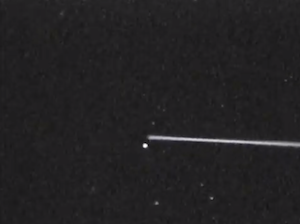
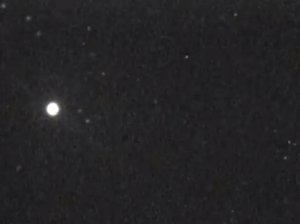
Two frames from a YouTube video shot January 4 2014 by Peter Maxwell Slattery, using a night vision monocular. The first frame shows Slattery aiming a laser at a dot moving steadily across the sky from right to left. The next frame is from a few seconds later and shows the “power up” effect. A YouTube search for “UFO laser pointer” brings up numerous videos with titles such as “UFO’s respond to laser pointers” and “UFO inspects my laser pointer”.
From NT News and the Herald Sun, via Open Minds. See also these other UFO-related laser pointer stories at LaserPointerSafety.com.
US: FAA updates laser reporting method in AC 70-2A
The changes include:
- Air Traffic Control can now regard a laser illumination of aircraft incident as an “in-flight emergency”, due to the potential debilitating injuries which could compromise safety and interfere with aircrew duties.
- New web-based methods by which pilots can report incidents
- Additional information in the Resources and the Related Documents sections
The key part of the document is the reporting procedure: “On arrival at destination, all aircrews that have been affected by an unauthorized laser illumination are requested to complete the Laser Beam Exposure Questionnaire. The questionnaire is located on the FAA’s Laser Safety Initiative Web site at http://www.faa.gov/about/initiatives/lasers/ and can be electronically submitted. The questionnaire may also be printed and faxed to the WOCC at (202) 267-5289, ATTN: DEN, or emailed to laserreports@faa.gov.”
From FAA Advisory Circular 70-2A
UK: Pilots want jail for persons aiming laser pens at aircraft
BALPA general secretary Jim McAuslan asked for a government cross-agency summit to address the problem. BALPA requested stronger regulations restricting the sale of high-powered lasers, more prosecutions, and action taken through trading standards.
He said that hotspots include airports at Manchester, Glasgow, Liverpool and Heathrow.
From ITV London and ITV Granada
US: FAA updates pilot reporting questionnaire
Flight information
- Aircraft type: Airplane, rotorcraft, lighter than air, other
- Type of operation: Commercial aviation, general aviation, military, law enforcement, medical, news reporting, other
- Time of day: Daytime, around sunset, dusk/twilight, nighttime before midnight local time, nighttime on or after midnight local time, around sunrise, dawn/morning twilight
- Phase of flight: Taxi, takeoff, climb to altitude, cruise altitude, descent, final approach, landing, low-altitude, hover, other
Effect on flight
- Did the laser interfere with crew duties? Yes (describe), no
- Did the laser cause a change in flight path? No, minor/non-adverse change, major/adverse change
- Did the laser disrupt a law enforcement, medical or military mission? Yes (describe), no
Illumination details
- Did the laser appear to track the aircraft? Yes, no, other
- Did the laser illuminate any part of the cockpit? Yes, no, other
- Did the laser shine directly into one or both of your eyes? Did not shine directly, shined a little, shined brightly
Effect on illuminated pilots or crew
- Choose from a list of vision effects: None, glare, temporary flashblindness or afterimages, blind spot(s), blurry vision, significant loss of night vision, other
- Choose from a list of physical effects: None, watering eyes, eye discomfort/pain, headache, shock, disorientation or dizziness, other
- Did you rub your eye after exposure: No, a little, vigorously
If there was an eye exam
- Type of doctor who did the most comprehensive exam: Retinal specialist, ophthalmologist, optometrist, optician, emergency room doctor/nurse, other
- List results of the exam
Prior laser knowledge
- Did you have any prior knowledge or training? None, basic info, detailed specific info on how to “recognize and recover”, simulator training with laser or laser-like exposure, other
From FAA Laser Beam Exposure Questionnaire
New Zealand: Pilots want laser pointers prohibited
The pilots expressed concern following the September 2012 conviction of a teenager who aimed a green pointer at three commercial aircraft and a police helicopter in January 2012.
The NZALPA president said “It has reached a stage where any member of the public can purchase a commercial grade laser and do what they please with it.”
From Radio New Zealand and Voxy
Israel: Advanced anti-laser filter announced
It is not clear whether the filter is available at this time (May 2012). The company intends to incorporate it into glasses and night-vision goggles worn by pilots, to protect against flash blindness, meaning power densities from 100 µW/cm² up to 1000 µW/cm².
From Optics.org
UK: Eye test for pilots available from CAA website
The ALESA card is available in hard copy, and can also be downloaded from CAA’s website. If downloaded, the Amsler Grid on the first page should be printed so it is 10 x 10 cm.
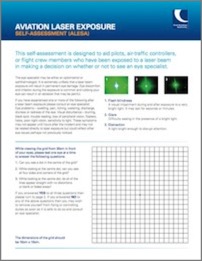
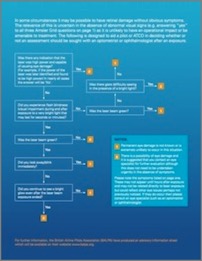
Click for PDF version from CAA ALESA webpage
When staring at the dot in the center of the grid, if the lines appear distorted or there are blank or faded areas, there may be a problem. The person is encouraged to remove themselves from aviation-related duties such as flying or air traffic control, and to see an eye specialist.
The second page has a flowchart of exposure conditions leading either to a “1” meaning unlikely eye damage or a “2” meaning eye damage possibility. If the person scores a “2”, the flowchart suggests they see an eye specialist.
From PilotWeb and the CAA ALESA webpage. The CAA press release about ALESA is here.
New Zealand: 100 incidents in 2011; pilots want Class 3 laser imports banned
There are currently no restrictions on the public’s ownership of lasers in New Zealand.
NZALPA’s technical director Stu Julian told TV ONE that if the laser incidents continue, they could cause a crash due to distracting a pilot when they have minimal reaction time.
According to the New Zealand Civil Aviation Authority, there were 100 laser pointer incidents in 2011, with 40 of those at the Auckland airport. A spokesperson for the Eagle police helicopter said the crew had lasers pointed at them “all the time. It happens fairly often and it’s a real risk to the crew.”
From MSN NZ, TVNZ, Scoop NZ, and the New Zealand Herald. The text of a Feb. 7 2012 press release from NZALPA is below (after the “Read More” link). Thanks to Mark Wardle of NZALPA for bringing this to our attention. The New Zealand Herald link has a list of selected New Zealand laser incidents. To find all aviation incidents from New Zealand reported at LaserPointerSafety.com, click here.
Click to read more...
South Africa: Up to 12 incidents per week, say pilots
ALPA-SA is calling for public education and a ban on handheld laser sales. According to the organization, there was a temporary drop in the number of incidents after media reports earlier in 2011, but the incidents are now on the rise again.
A spokesperson for the Civil Aviation Authority said “a few cases” had been reported thus far in 2011. He added that if the International Civil Aviation Organization introduced new regulations, the CAA would “definitely look into implementing it.”
From the Cape Argus
South Africa: 70 incidents in 2011, including a go-around; no arrests
The majority of South African incidents occurred in Cape Town, with other reports at OR Tambo, Wonderboom in Pretoria, and Lanseria International. In an incident in Lanseria, “two pilots were blinded so badly that after landing they couldn’t see the man who signaled where to park the plane” according to News24.com.
There were no persons arrested during 2011 for aiming a laser at aircraft. Over all years, there have only been two incidents resulting in arrests (as of January 11 2012):
- Around January 7-8 2012, three persons were arrested for pointing green laser beams at helicopters using the Bloemfontein civil and Air Force airports.
- During the 2010 World Cup, a man temporarily blinded a helicopter pilot in Durban
A Civil Aviation Authority spokesperson said “It is a serious hazard to point laser lights at aircraft.” The maximum penalty for an offense is a “hefty fine and up to 30 years in jail.”
The general manager of the Air Line Pilots Association of South Africa said ALPA-SA members were reporting increasing numbers of incidents where “sudden and intense bursts of light [are] deliberately shone at aircraft…”
From The New Age and DefenceWeb
Commentary from LaserPointerSafety.com: The figure of 70 incidents reported to ATNS in 2011 is probably low. A May 5 2011 news story quoted ALPA-SA as saying they receive between 10 and 12 complaints from pilots every week. That would result in 520 to 624 laser illuminations per year. Also, the 70-incident figure may be a misunderstanding or misquote. A news story from March 2011 quotes ALPA-SA as saying there were 70 incidents in the 10 months from April 1 2010 through February 28 2011; see News24.com.
.
US: FAA urges pilots, public to report incidents on new webpage
- Reporting Laser Incidents: How to report an incident, for pilots, air traffic control officials, and the general public
- U.S. Laser Incidents by Year: A simple table listing incidents each year since 2005
- Laser Events and Civil Penalties: Press releases about the number of incidents in 2010 and about the June 2011 decision to impose civil fines of up to $11,000. Also, the legal interpretation justifying imposition of the fines.
- Hazards of Laser Illumination: Links to background information for pilots, and two studies of the issue by FAA’s Civil Aerospace Medical Institute
- Planning Light Shows and Other Outdoor Laser Operations: Information and forms for persons planning to use lasers outdoors
Below is the FAA press release announcing the web page:Click to read more...
US: UPDATED - Myrtle Beach CAP official witholds safety flights after being charged for confiscating laser pointer from 12-year-old (+ 2 updates)
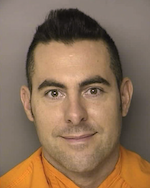
Stephen Teachout
In retaliation, Teachout said the three-pilot Civil Air Patrol would not provide help to Horry County (where Mytle Beach is located) for certain calls including offshore missing persons and forest fires. According to the Sun News, Teachout said “I support Horry County but if they don’t have [the pilots’] backs then no thanks. We don’t need to be here.”
Click to read more...Grenada: Increasing incidents
Violators could be charged with interfering with air crew duties. The Authority is looking for the laser perpetrator(s), and has posted notices in newspapers stating that shining lights at aircraft is “a security offense”. Also, several pilots have filed complaints with the Eastern Caribbean Civil Aviation Authority.
From the Virgin Islands News Online
Canada: Pilots want lasing to be a criminal offense
Currently, violations of the Aeronautics Act can lead to fines of up to $100,000 and up to five years in prison. Despite this, laser illuminations continue to occur.
In 2010, there were 182 reported laser pointing incidents. Ontario had the highest number, 69, followed by Quebec with 53 incidents. Transport Canada and the ACPA said this was due to increased reporting, copycat laser use, and the increased availability of laser pens and pointers.
“This is just like shooting a gun at an airplane around [an] airport,” according to Nick Stoss, formerly with the Transportation Safety Board.
From Global Winnipeg
South Africa: Incidents are increasing; pilots express concern
A representative of the Civil Aviation Authority said that laser misuse violates two sections of the Civil Aviation Regulations, and can be punished with a fine and/or imprisonment of up to 10 years. (There was an arrest in 2010 during the World Cup, when 35-year-old Yusuf Ebrahim temporarily blinded a helicopter pilot.) The CAA representative said the Authority would consider new standards or regulations if they were recommended by the International Civil Aviation Organization.
To report a laser illumination incident in South Africa, CAA said to email information to cahrs@caa.co.za or fax it to 011 545 1453.
From Independent OnLine Scitech. An IOL story about Yusuf Ebrahim’s first court appearance is here.Click to read more...